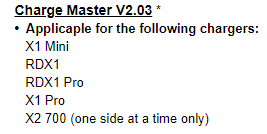So it hasn’t detoriated very much then. Each cell in the 4S2P is 12 to 22mOhm which is only a fraction lower than the 13 to 25mOhm of the more used battery.
I never really looked at the internal resistance before, I kept a mental note of how well my various packs seem to last on activations. But I’m trying to find the best 9x 18650 cells I have to take with me next week when on a Completes gathering expedition in HB9 land. The acquisition of a scrap laptop pack had me scratching about trying to figure out how to pick the best out of the 21x 18650 cells I have which is when I starting measuring the internal resistance.
At that sort of R level how do you reliable but temporary connexions for testing?
To measure internal resistance you measure the offload voltage, apply lowish value resistor and measure the onload voltage then apply Ri = (V1-V2)*R/V2 to get the internal resistance. The connections don’t change between the two voltage measurements so I have been considering how accurate the process is. It’s probably accurate enough but isn’t going to be to lab calibration standards
Spinning 18650s around in a sprung holder I’d not be surprised if the series resistance at the contacts varied a good amount. So if you were comparing cells in a holder like that it might not be reliable. But they don’t like lots of soldering cycles either I suppose (if they even have tabs)?
ISTR the LiFePO where quite repeatable in the consistency of reading. I’ll do some 18650 tests later. I’m doing a discharge test on 3x 3000mAhr cells now which were reporting 190-200mOhms and it’s very noticeable how the voltage collapses on them at 400mA load compared to some other cells reporting around 100mOhm values.
After chat with HobbyKing support, I asked them about the ‘Charge Master’ software for the Turnigy charger. I can now view/control the charger via my PC and get some graphs 
From

I downloaded v2.03 of the Charge Master software and connected via a USB cable connected to the charger and power connected to a PSU .
18650 LiIon discharge test results.
All cells charged as LiPO at 500mA stop voltage 4.2V. LiIon can be charged as LiPO, the end voltage is 4.2 not 4.1V and gives a slightly higher capacity. Discharge was at 400mA (close to 817 RX current draw), stop voltage 3.2V.
3x LG 3000mAhr ex-laptop pack. Internal resistance 170-200mOhm. After 2hrs I stopped the test as the cells were showing 9.8 for the pack after only ~800mA used. These 3 cells look to be very tired. The Dell laptop pack they came from had been swapped as it was not holding charge well. All cells read around 3.7V each when it was dismantled.
3x Sanyo 2200mAhr ex-laptop pack. Internal resistance 100-120mOhm. After 3 hours the timer stopped the test. The voltage was 11.25V after ~1.2A used. These 3 look to be really quite healthy. I’m happy they will run an 817 for 2 good activations. The HP laptop pack these came from had no output when tested nor would it accept charge. The electronics in the pack had failed, there was scorching on the PCB. All 12 cells seem to be good. I don’t think the cells were used that much before the BMS electronics failed.
It does seem that the rise in internal resistance is a good indicator of health as the cells become less able to hold and deliver charge. Both Sanyo and LG data sheets say the cells start out at around 50-60mOhm so both my sets have aged. The Sanyos, whilst of lower capacity, are in a very usable state unlike the LGs. I’ll do a few charge / discharge cycles to see if the LGs just need “waking up” but I think they’ll be going for recycling.
I’ve been doing some more 18650 experiments. The recently aquired cells that showed poor life seem to be doing a Lazarus. I have been discharging them at 400mA on my IMAX B6 then charging at 500mA as LiPO cells. At first I could only get about 2hrs out of a set. But after 3 full discharge/charge cycles they will now provide 400mA for over 3 hrs. There’s probably another hour of life in them. Also noted was the internal resistance dropping but this is influenced by the changes in contact resistance.
We send the old laptops fro recycling in work. (Lenovo’s) I might have to investigate options.
The update on the battery I thought I had killed. I used it for a few hours during the weekends s2s gathering and I think I finished with 11.9v after a mix of 2m FM and SSB. 36 contacts or there abouts. So I think the battery lives for a bit longer!